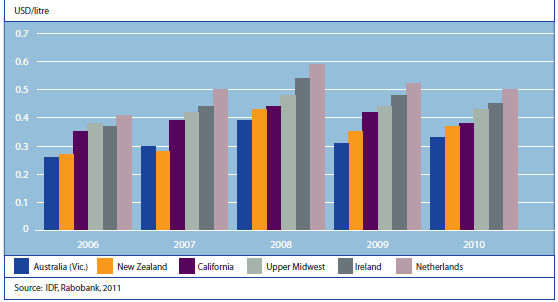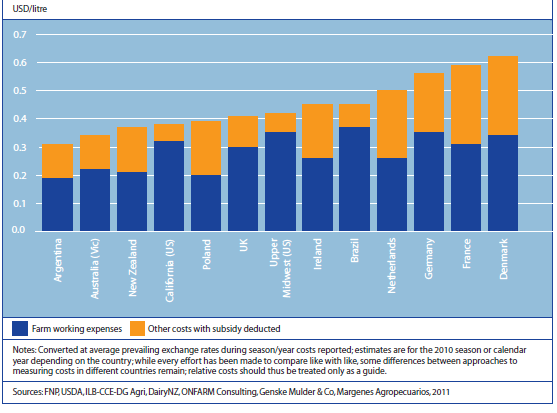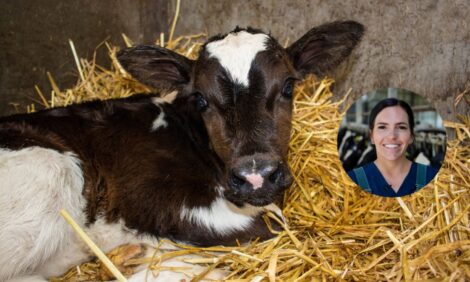



Global Dairy Outlook: Not Getting any Cheaper
The global dairy market will offer strong growth prospects in the coming five years, but the uneven spread of this market expansion and an era of elevated pricing will create as many challenges as opportunities for key players along the dairy supply chain. This is one of the key conclusions coming out of the Rabobank Food & Agribusiness Research and Advisory report, “Global Dairy Outlook: Show me the money”.The cost of producing exportable milk to remain high
The cost of producing milk varies considerably among farms, even between neighbours, depending on the system of farming used and the farmer’s goals and abilities. Costs on the same farm can also vary considerably from year to year, affected by weather conditions, input costs and decision-making.
Nonetheless, farmers in some regions are able to produce at lower costs than farmers in others due to a combination of natural factors including climate, soil and proximity to feed, and man-made factors, including herd genetics, availability of technology and operator expertise. Historically, the Southern Hemisphere milk producers (Australia, Argentina and New Zealand) had significantly lower costs due to their extensive pasture-based milk production systems, relatively cheap factors of production and low inputs. By contrast, Northern Hemisphere producers (the US and particularly the EU countries) had significantly higher production costs associated with intensive feed operations, high fixed costs and an ingrained reliance on domestic market support mechanisms.
Regardless of the region and farm in question, almost all dairy farmers saw a substantial increase in the costs of producing milk in the years after 2006. Key drivers included a step change in the costs of grain-based feeds after the global commodity boom, the associated escalation of fertiliser costs, higher costs of complying with tightening environmental regulations and higher debt costs (commonly driven by acquiring more land, the price of which had also leapt).
For the purposes of this report, Rabobank collated production cost estimates for farmers in a range of export regions (see Figures 2.1 and 2.2). These data (and data from previous studies) are shown in the two charts below—depicting, respectively, the change in production costs over time in five regions, and in a wider range of regions in 2010, based on the most recent data generally available).
Key observations include:
- In most regions production costs were lower in 2010 than in 2008. This can be mainly attributed to lower feed and fertiliser cost.
- Costs nonetheless remained well above 2006 levels.
- Southern Hemisphere regions typically enjoy low costs of production.
- But the spread between low cost production regions and mid-table regions has narrowed in recent years. This can be attributed to a weaker US dollar and rising debt costs in the Southern Hemisphere associated with increasing land costs.
Development of Milk Production Costs (on farm), 2006-2010

The cost of producing milk in each region in the future will depend upon the costs of key resources used in the process and the productivity with which they are used.
There are still good reasons to believe that the costs of many important resources (including inputs and land) will remain at or near elevated levels in the medium term. Indeed, in Rabobank’s view, 2010 will mark something of a low point in the costs of key input commodities over the course of the coming five years. While farmers have an exceptional track record of improving the productivity with which these resources are used, there is a very good chance that the pace of productivity growth will fall short of input cost increases in the coming years, keeping the cost of producing milk higher than in most of recent history—somewhere between 2008 and 2010 levels.
Average Milk Production Costs (on farm), 2010

If costs stay high, so too will commodity prices
Rabobank’s central thesis for the global market over the next five years is that:
- Demand in emerging regions will exhibit solid growth.
- While much of the additional milk required to meet demand in these regions will be found locally, a rising volume will need to come from outside sources.
- Supply growth in lower cost regions (notably New Zealand, Australia and Argentina) will be insufficient to match this requirement for export volumes alone.
- A significant share of increased exports will thus have to come from higher cost regions, where expansion is less constrained.
- Global dairy prices will thus have to trade at high levels to generate the farmgate milk prices that will trigger investment on farms in these regions, particularly when input costs are likely to remain high for years to come.
Based on this scenario, for some years now Rabobank has outlined a forecast average price for WMP in international markets of between USD 3,300 to USD 3,800 per tonne—enough to cover production costs of, and hence elicit investment by, competitive farmers in mid-table cost regions.
The thesis and target price range appear to have held up well in recent years. Our revised assessment of the market, completed for the purposes of this report, yields no compelling reason to change expectations on either front.
An efficient cooperative selling WMP on world markets and stripping out only the costs of manufacturing and transport would be able to pay an average milk price of between USD 0.36 per litre to USD 0.43 per litre at the farmgate under this scenario.
February 2012


